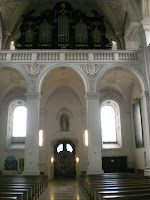 On the 14th of April, Sister Walters and I started on our new mission assignment to Budapest, Hungary. Our job is to carry laptop computers so that the members in the various Stakes throughout Europe can learn first hand how to work the New Family Search and the new indexing programs. Our Supervisor Bro. Richard Walker does the teaching now because he speaks German. He is highly respected for his knowledge in Genealogy research and we hope he can help us find our German ancestors. He has two Doctor's Degrees and was an assistant District Attorney in Seattle, Washington. We really do enjoy working with him. Our job is actually more than just delivering computers however. We are responsible for them, so they are our babies so to speak. We can never leave them in the car unattended. We also have to be careful when we leave them in our Motel room. When we get to the conferences that are given, we set up, take down and help on the computers. Richard told sister Walters that he wanted her to give the next seminar. I know she will enjoy doing that.
On the 14th of April, Sister Walters and I started on our new mission assignment to Budapest, Hungary. Our job is to carry laptop computers so that the members in the various Stakes throughout Europe can learn first hand how to work the New Family Search and the new indexing programs. Our Supervisor Bro. Richard Walker does the teaching now because he speaks German. He is highly respected for his knowledge in Genealogy research and we hope he can help us find our German ancestors. He has two Doctor's Degrees and was an assistant District Attorney in Seattle, Washington. We really do enjoy working with him. Our job is actually more than just delivering computers however. We are responsible for them, so they are our babies so to speak. We can never leave them in the car unattended. We also have to be careful when we leave them in our Motel room. When we get to the conferences that are given, we set up, take down and help on the computers. Richard told sister Walters that he wanted her to give the next seminar. I know she will enjoy doing that.We drove to Passau, also known as the Venice of Bavaria, where we decided to spend the night. It is in East Germany so we feel privileged to be able to even go to Passau. It is near the Austrian border. This was also one of the stopovers for the famous princess Elisabeth of Bavaria, better known as Sissi, on her way to the Imperial Throne of Austria. It was once the largest geographical area in the entire Holy Roman Empire of the German Nation.
In the morning we took a driving tour of the city. Below are a few of the major places of attraction. The New Residenz has served as the palace of the prince bishops since its completion in 1730. In front is the Wittelsbacher Fountain which was built in the Baroque style. It commemorates the annexation of Passau to Bavaria. Napolean Bonaparte lodged here in 1809.
Next we saw the St. Stephen's Cathedral. It is a beautiful building with blue green copper Baroque cupolas. It was built in 1674 but from notes that were found, we learn that the first St. Stephens church was built in 731 AD. This church boasts the world's largest organ, an 18th century Gilt pulpit. The art work here is extensive and huge. There are 171 in all painted by Carpoforo Tencalla. The High Alter is a representation of the stoning of St. Stephen. I was amazed at the ornateness of the Organ, gold everywhere. I took pictures of the stucco work which was amazing. I think you will get a good idea of how beautiful this cathedral is.
St Paul's Baroque Church was our third place to visit. This church dates back to 1050 in the Romanesque and Gothic style. Instead of focusing on frescos and statues, its focus was on the furnishings, especially the alters. They are all hand carved out of black stained wood and they are adorned with gilt ornamentation. There is a large guilt statue of St. Paul at the front of the church.
The last place we saw was situated high up on a hill in Passau. The citadel Veste Oberhaus started its construction in 1217. From here you can see how the three rivers converge one with another. The Ilz has dark water that comes from the Bavarian Forest, the Inn River with its light green water and the Danube with its blue water create a stark contrast.. This is a most unusual occurrence and the only one in the world that I know of. These three rivers made this area ideal for trading goods as far back as the crusades. We had to get to bed early so we ate dinner at McDonalds and got a good nights rest for the rest of our trip to Budapest.
NEW RESIDENZ


CITY OF PASSAU








ST. STEVENSDOM CHURCH
























ST. PAUL'S BAROQUE CHURCH










 VESTE OBERHAUS
VESTE OBERHAUS


TOWN HALL
LEAVING PASSAU

What a beautiful place. I love the different colors on the buildings. I wonder what they would say if they came to America ans saw all the beige stucco houses.
ReplyDeleteI can't imagine how they would feel, Europe is such an artistic part of the world. We have so many advantages in America but you can't beat Europe for the beautiful buildings and just think they are older than the 1500's. They have such a heritage behind them. You can feel the oldness of the cities. The spirit there is older.
ReplyDelete